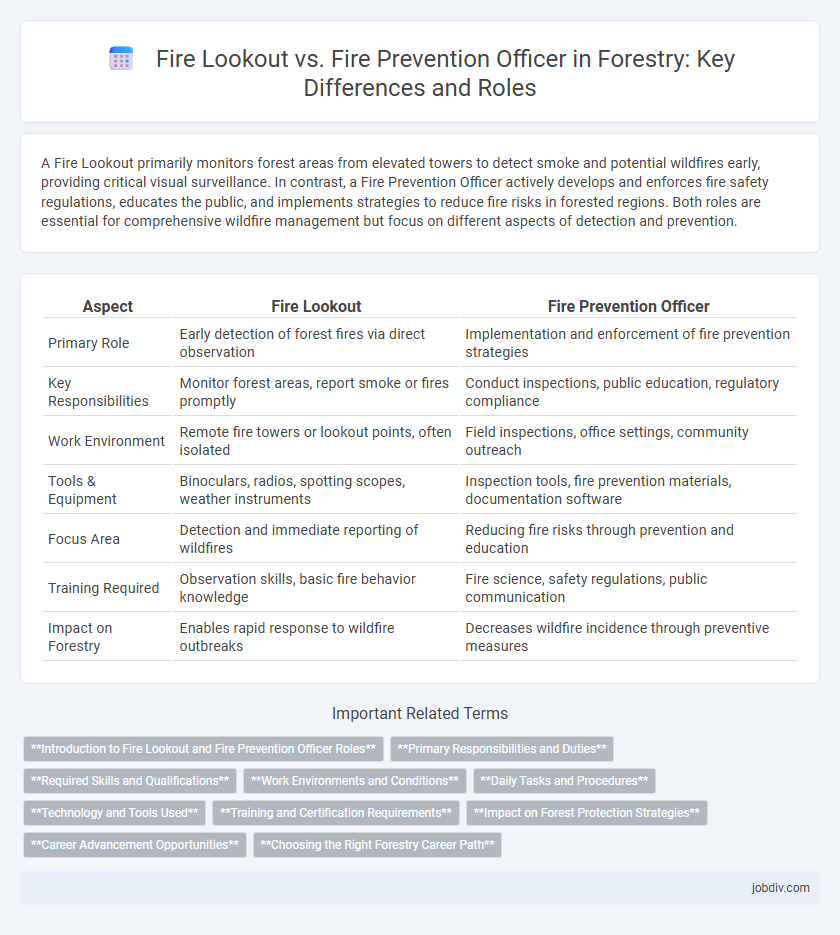A Fire Lookout primarily monitors forest areas from elevated towers to detect smoke and potential wildfires early, providing critical visual surveillance. In contrast, a Fire Prevention Officer actively develops and enforces fire safety regulations, educates the public, and implements strategies to reduce fire risks in forested regions. Both roles are essential for comprehensive wildfire management but focus on different aspects of detection and prevention.
Table of Comparison
| Aspect | Fire Lookout | Fire Prevention Officer |
|---|---|---|
| Primary Role | Early detection of forest fires via direct observation | Implementation and enforcement of fire prevention strategies |
| Key Responsibilities | Monitor forest areas, report smoke or fires promptly | Conduct inspections, public education, regulatory compliance |
| Work Environment | Remote fire towers or lookout points, often isolated | Field inspections, office settings, community outreach |
| Tools & Equipment | Binoculars, radios, spotting scopes, weather instruments | Inspection tools, fire prevention materials, documentation software |
| Focus Area | Detection and immediate reporting of wildfires | Reducing fire risks through prevention and education |
| Training Required | Observation skills, basic fire behavior knowledge | Fire science, safety regulations, public communication |
| Impact on Forestry | Enables rapid response to wildfire outbreaks | Decreases wildfire incidence through preventive measures |
Introduction to Fire Lookout and Fire Prevention Officer Roles
Fire Lookouts serve as vigilant observers stationed in elevated towers or remote locations, tasked with the early detection and reporting of wildfires through visual surveillance. Fire Prevention Officers focus on developing and implementing strategies to reduce wildfire risks by educating the public, enforcing regulations, and coordinating controlled burns. Both roles are critical to comprehensive wildfire management, combining real-time monitoring with proactive prevention efforts.
Primary Responsibilities and Duties
Fire Lookouts primarily monitor forests from elevated towers to detect smoke and wildfires early, providing critical, real-time alerts to firefighting teams. Fire Prevention Officers focus on developing and enforcing wildfire prevention strategies, conducting risk assessments, public education, and implementing prescribed burns to reduce combustible materials. Both roles are essential for wildfire management, with Lookouts emphasizing detection and Prevention Officers targeting mitigation and public safety.
Required Skills and Qualifications
Fire Lookouts require keen observational abilities and basic training in wildfire detection, often involving certifications in fire spotting and communication systems. Fire Prevention Officers need advanced knowledge in forestry management, fire behavior, and public safety regulations, typically holding degrees in environmental science or forestry alongside certifications in fire prevention and emergency response. Both roles demand strong physical fitness, decision-making skills, and the ability to work in remote or high-risk environments.
Work Environments and Conditions
Fire Lookouts typically operate in remote, elevated towers or lookout posts within dense forested areas, enduring extended periods of solitude and exposure to varying weather conditions. Fire Prevention Officers work in more diverse environments, including administrative offices, public venues, and field sites, where they collaborate with communities and conduct inspections under variable outdoor conditions. Both roles demand adaptability to rugged terrains and sometimes hazardous environments, but Fire Lookouts face more isolated and physically demanding settings.
Daily Tasks and Procedures
Fire Lookouts conduct continuous visual surveillance from high vantage points, scanning for signs of smoke and fire, maintaining communication with firefighting teams, and recording weather and fire conditions throughout their shifts. Fire Prevention Officers develop and implement forest fire prevention strategies, conduct public education programs, inspect properties for fire hazards, and enforce fire regulations by coordinating with local authorities. Both roles involve real-time monitoring and reporting but differ as Lookouts provide immediate fire detection while Officers focus on proactive prevention and regulatory oversight.
Technology and Tools Used
Fire Lookouts utilize elevated observation towers equipped with high-powered binoculars, digital cameras, and GPS devices to detect and report wildfires promptly. Fire Prevention Officers employ advanced GIS mapping software, remote sensing technology, and fire modeling tools to analyze fire risk, plan controlled burns, and manage forest fuel loads. Both roles integrate drone surveillance and real-time weather data systems to enhance fire detection and prevention strategies.
Training and Certification Requirements
Fire Lookouts typically require basic wildfire observation training and certification in fire spotting techniques, often completed through specialized forestry courses or on-the-job training. Fire Prevention Officers must obtain advanced certifications such as Certified Fire Specialist or Wildland Fire Management credentials, including comprehensive knowledge in risk assessment, firefighting strategies, and public safety regulations. Both roles demand ongoing education and compliance with state or federal forestry agency standards to ensure effective wildfire detection and prevention.
Impact on Forest Protection Strategies
Fire Lookouts provide early detection of wildfires through direct observation, enabling rapid response to contain fires before they spread. Fire Prevention Officers develop and implement comprehensive strategies, including public education and vegetation management, to reduce the risk of fire ignition. Together, these roles enhance forest protection by combining immediate fire detection with long-term prevention measures, significantly mitigating wildfire damage.
Career Advancement Opportunities
Fire Lookouts primarily gain experience in early fire detection and surveillance, which can lead to advancement into roles such as Fire Prevention Officer or Forest Ranger, where broader responsibilities include strategic planning and community education. Fire Prevention Officers have more direct involvement in managing and implementing fire prevention programs, opening career paths toward senior fire management positions or specialized roles in wildfire mitigation and policy development. Career growth in forestry emphasizes developing expertise in fire behavior, risk assessment, and interagency coordination, critical for leadership roles in wildfire management and prevention.
Choosing the Right Forestry Career Path
Choosing between a Fire Lookout and a Fire Prevention Officer involves evaluating job responsibilities and career goals within forestry. Fire Lookouts specialize in early wildfire detection by monitoring remote forested areas, utilizing surveillance techniques and weather data to identify potential threats. Fire Prevention Officers focus on developing and enforcing strategies to reduce fire risks, including public education, controlled burns, and regulatory compliance, making them ideal for those interested in proactive forest management and community safety.
Fire Lookout vs Fire Prevention Officer Infographic

 jobdiv.com
jobdiv.com